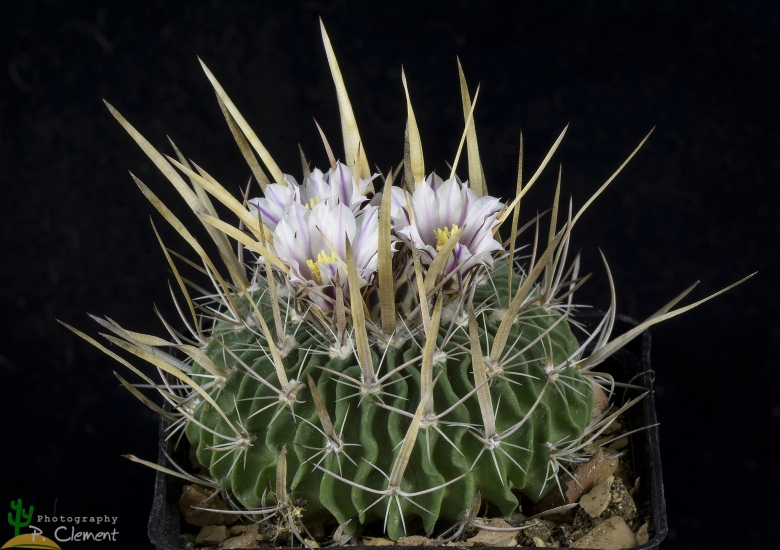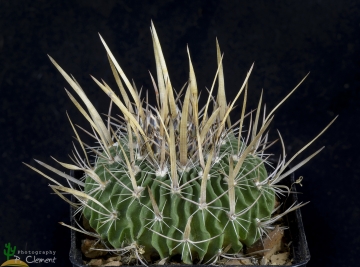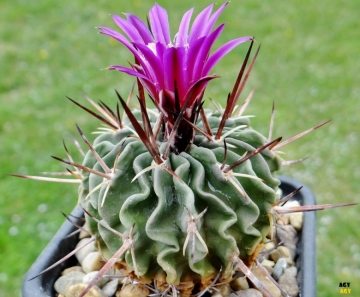
Stenocactus obvallatus Photo by: Peiffer Clement
Origin and Habitat: Stenocactus obvallatus is endemic to central México from the states of Aguascalientes, Durango, Guanajuato, Hidalgo, México Distrito Federal, México State, Oaxaca, Querétaro, San Luis Potosí, and Tamaulipas.
Habitat and Ecology: The species is very likely to occur in desert scrub. The genus Stenocactus is in need of taxonomic revision because there is a general lack of understanding on the taxonomic position of the species within the genus and thus is it no possible to define either the spatial or systematic limits of the taxon. It is not possible to establish its population size as its taxonomy is uncertain.
Synonyms:
See all synonyms of Stenocactus obvallatus
back
Accepted name in llifle Database:Stenocactus obvallatus (DC.) A.BergerKakteen (Berger) 248, 346 (1929)Synonymy: 19
back
Common Names include:
SPANISH (Español): Tepenexcomitl (Mexico)
Description: Stenocactus obvallatusSN|6285]]SN|6285]] is a ball-shaped, cactus with wavy-margined ribs. White areoles each bear 5–12 greyish-brown spines. In spring, has pale yellow to pale pink flowers, with a purplish-red stripe on each petal. Stenocactus obvallatusSN|1730]]SN|6285]] is strictly related to Stenocactus multicostatusSN|6285]]SN|1730]]. However the two are easy to tell apart. E. multicostatus plants have many pale green ribs (as many as 120) where Stenocactus obvallatusSN|6285]]SN|6285]] typically has less than 50 blue-green ribs.
Remarks: There is much variation within this species, the taxonomic position, habitats and ecology and populations size need further investigation, some of the “obvallatus” may correspond to other species.
Stem: Obovoid to globose, usually solitary but sometimes forming two stems, greyish or blue-green, depressed at apex reaching a height of 6-10 (or more) cm and width of 6-11(-15) cm.
Ribs: 25 to 50, rather thin and undulate, very broad at the areoles.
Areoles: 2-4 on each rib.
Spines: About 5-12, of which 3(-4) central spines subulate, ascending or spreading, the upper one flattened and wide, reddish brown, to 5 cm long, 3-4 mm wide, lateral 2 even wider, angular, spreading, and 4-6 radial spines shorter, white, perhaps not one-fourth the length of the longer ones (about 1 cm long).
Flowers: Flower buds are are held in the wool of the stem's apex, often with just the tips visible until early spring, when some sunny days come along and both the buds and plant start to grow. The plant will throw quite a few buds in and open several 3 cm flowers at a time over the course of a month. If the conditions are right it can bloom again later in the year. The blooms are quitw large, pale yellow or white, with purplish midstripes and reddish center; perianth-segments linear-oblong.
Subspecies, varieties, forms and cultivars of plants belonging to the Stenocactus obvallatus group
Bibliography: Major references and further lectures
1) Edward F. Anderson “The Cactus Family” Timber Press, 2001
2) Christopher Brickell “RHS Encyclopedia of Plants and Flowers” Dorling Kindersley Ltd, 01 set 2010
3) “Botanica: The Illustrated A-Z of Over 10,000 Garden Plants and how to Cultivate Them” Mynah, 1997
4) Gómez-Hinostrosa, C., Sánchez , E., Guadalupe Martínez, J. & Bárcenas Luna, R. 2013. Stenocactus obvallatus. The IUCN Red List of Threatened Species. Version 2015.1. <www.iucnredlist.org>. Downloaded on 03 June 2015.
5) Nathaniel Lord Britton, Joseph Nelson Rose “The Cactaceae: Descriptions and Illustrations of Plants of the Cactus Family” Volume 3, 1922
6) Hans Hecht “BLV-Handbuch der Kakteen” BLV-Verlagsgesellschaft, 1982.
7) James Cullen, Sabina G. Knees, H. Suzanne Cubey “The European Garden Flora Flowering Plants: A Manual for the Identification of Plants Cultivated in Europe, Both Out-of-Doors and Under Glass” Cambridge University Press, 11/Aug./2011
8) David Hunt, Nigel Taylor “The New Cactus Lexicon” DH Books, 2006
9) Curt Backeberg: “Die Cactaceae: Handbuch der Kakteenkunde.” Volume V. 2. edition. 1984
10) Walther Haage: “Kakteen von A bis Z.” 3. edition. Quelle & Meyer, Heidelberg 1986
11) Cactus and Succulent Journal of Great Britain. 12: 81, London 1950
 Stenocactus obvallatus Photo by: Peiffer Clement
Stenocactus obvallatus Photo by: Peiffer Clement Field number MK104.359 (Collector Miloš Kaplan) Locality: San Antonio Anaya, Hidalgo, Mexico. Photo by: Agócs György
Field number MK104.359 (Collector Miloš Kaplan) Locality: San Antonio Anaya, Hidalgo, Mexico. Photo by: Agócs GyörgyCultivation and Propagation: Stenocactus obvallatusSN|6285]]SN|6285]] is easy to to care cactus, recommended for any collection that needs lots of light with ample airflow.
Growth rate: It is a small growing, but easily flowering species.
Soils: It needs regular cacti soil with little organic matter (peat, humus).
Repotting: Repotting every other year. As it is especially prone to rot under-pot in a smaller container filled with very porous compost. Use pot with good drainage.
Watering: Water regularly in summer, but do not overwater (very wet-sensitively, especially in light of its succulent root system), allow to dry between watering. Its roots are easily lost in pots that stay damp for any length of time. It should not be watered at all in winter. In the rest period no high atmospheric humidity!! Care must be taken with watering as they tends to become swollen and untidy in growth habit if given too much water and shade.
Fertilization: During the growing season enrich the soil using a fertilizer rich in potassium and phosphorous, but poor in nitrogen, because this chemical element doesn’t help the development of succulent plants, making them too soft and full of water.
Hardiness: Reputedly sensitive to frost , but less so if kept on the dry side prior to, and during, cold weather (hardy to -5° C for short periods). However some warmth throughout the year will increase the grower's success (minimum 5° to 8°C during rest season).
Exposition: Outside bright sun it likes strong sunshine, but is tolerant and do well with light shade during the hot Summer months, inside it needs bright light, and some direct sun. Subject to sunburn if exposed to direct sun for too long. Tends to bronze in strong light, which encourages flowering and heavy wool and spine production.
Uses: It is an excellent plant for container growing. It always looks good and stays small. It look fine in a cold greenhouse and frame.
Pests & diseases: It may be attractive to a variety of insects, but plants in good condition should be nearly pest-free, particularly if they are grown in a mineral potting-mix, with good exposure and ventilation. Nonetheless, there are several pests to watch for:
- Red spiders: Sensitive to red spider mite. Overhead watering is helpful in controlling mites.
- Mealy bugs: Occasionally mealy bugs they develop aerial into the new growth among the wool with disfiguring results, but the worst types develop underground on the roots and are invisible except by their effects.
- Scales: Scales are rarely a problem.
- Rot: Rot it is only a minor problem with cacti if the plants are watered and “aired” correctly. If they are not, fungicides won't help all that much.
Propagation: Seeds (usually). Seeds germinate in 7-14 days at 21-27° C in spring, remove the glass cover gradually as the plants develops and keep ventilated, no full sun for young plants! The seedlings should not be disturbed until they are well rooted, after which they can be planted separately in small pots.












